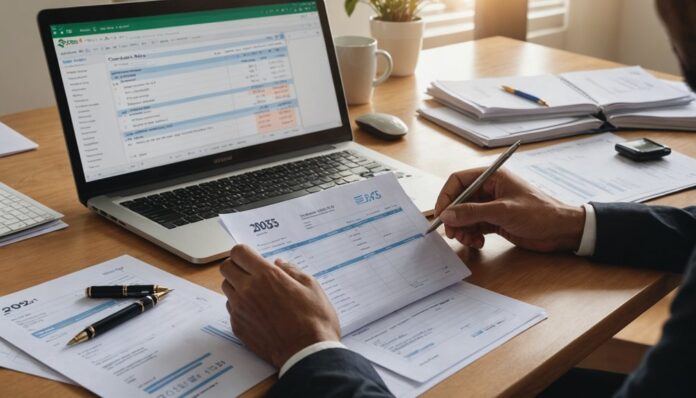As individuals anticipate their 2025 tax refund, they have a unique opportunity to enhance their financial stability. By allocating the refund strategically, they can make noteworthy progress in achieving their financial goals. From paying off high-interest debt to investing in a tax-advantaged retirement account, the options are varied. The key is to prioritize one’s financial needs and make informed decisions to maximize the refund’s impact, setting the stage for long-term financial security.
Highlights
- Utilize your tax refund to pay off high-interest debt, such as credit cards and loans, to save on interest payments.
- Allocate your refund towards building an emergency fund to cover 3-6 months of living expenses and ensure financial stability.
- Invest a portion of your refund in a tax-advantaged retirement account, such as a 401(k) or IRA, for long-term stability.
- Use your refund as a down payment on a significant purchase, such as a home, to reduce financing amounts and lower monthly payments.
- Put your refund towards a long-term savings goal, such as a home down payment or retirement, to enhance your financial future and stability.
Pay Off High-Interest Debt
A hefty tax refund can be a welcome windfall, providing a chance to tackle pesky high-interest debt that’s been lingering. Implementing smart debt consolidation strategies allows individuals to efficiently apply their refund, potentially saving money on interest payments and accelerating debt repayment.
One effective approach is to prioritize high-interest debts, focusing on credit cards or loans with the highest rates. Interest rate negotiation may also be possible, as creditors might be willing to work with borrowers who demonstrate a clear commitment to paying off their debts.
Boost Your Emergency Fund
Once high-interest debt is under control, allocating a tax refund towards an emergency fund can provide long-term financial stability.
A well-stocked emergency fund serves as a safety net, shielding individuals from financial shocks such as unexpected medical bills, car repairs, or job loss. By directing a tax refund towards emergency savings, individuals can build a cushion to fall back on, ensuring financial security and peace of mind.
Experts recommend aiming for three to six months’ worth of living expenses in an easily accessible savings account. By prioritizing emergency savings, individuals can avoid going into debt when unexpected expenses arise, ultimately reinforcing their financial foundation and nurturing a sense of belonging in their financial lives.
Invest in a Tax-Advantaged Retirement Account
While building an emergency fund provides an essential safety net, investing in a tax-advantaged retirement account offers a proactive approach to securing long-term financial stability.
Utilizing a portion of a tax refund to enhance retirement savings can have a lasting impact on one’s financial future. Tax benefits, such as deductions or credits, can increase the value of each dollar contributed.
By directing funds into a 401(k), IRA, or Roth IRA, individuals can create a dedicated stream of income for their golden years. Consistently investing in a tax-advantaged retirement account can cultivate a sense of belonging to a financially secure community.
This strategy allows individuals to proactively manage their financial well-being and make the most of their tax refund.
Use It for a Down Payment on a Big Purchase
Financial freedom is within reach when a tax refund is employed strategically. Using a tax refund as a down payment on a big purchase can be a smart move, especially for those considering home purchase options.
By putting the refund towards a down payment, individuals can reduce the amount needed to be financed, resulting in lower monthly payments and interest rates. This approach can also help with budgeting strategies, as it allows for a significant upfront payment, reducing the financial burden of the purchase.
Additionally, using a tax refund in this way can help individuals achieve their long-term goals, such as owning a home, and create a sense of financial stability and security. This strategic use of a tax refund can have a lasting impact on one’s financial well-being.
Put It Toward a Long-Term Savings Goal
A substantial tax refund can be a powerful catalyst for achieving long-term savings goals. By incorporating the refund into savings strategies, individuals can make significant progress toward securing their financial future.
Allocating the refund toward a specific goal, such as retirement or a down payment on a house, can provide a sense of direction and purpose. Effective financial planning involves setting clear objectives and leveraging available resources to achieve them.
Utilizing a tax refund as a means to enhance savings can have a lasting impact, ultimately leading to increased financial stability and peace of mind. By adopting this approach, individuals can cultivate a sense of belonging among those who prioritize their financial well-being.
Conclusion
Utilizing a 2025 tax refund effectively is essential for achieving financial stability and growth. By prioritizing debt repayment, building an emergency fund, and investing in a retirement account, individuals can secure their financial future. Alternatively, using the refund for a down payment or long-term savings goal can encourage financial security. By making informed decisions, taxpayers can turn their refund into a significant opportunity for long-term financial success and peace of mind.


